How to Write a Management Summary for Your Business Plan
Entrepreneurs are often celebrated for their uncanny ability to understand others – their customers, the market, and the ever-evolving global...
4 min read
![]() Ben Worsley
Nov 30, 2022 3:05:54 PM
Ben Worsley
Nov 30, 2022 3:05:54 PM
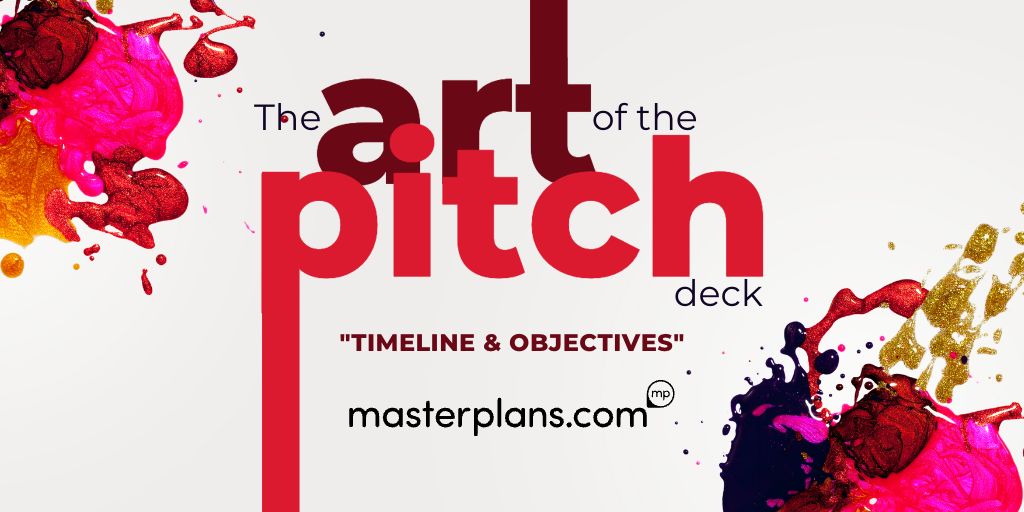
Note: This is the second post in our "Art of the Pitch Deck" series, in which we examine the various slides of a typical pitch deck and discuss visual communication techniques that have proven effective for our clients.
In our first post, we took a look at the Marketplace slide, which startups use to show the company’s market potential and where it is positioned within it. And if you’re looking to see what the other slides are in a pitch deck (and want a sneak peak at what’s to come in this blog series), you can see our introduction to the pitch deck.
It is critical for a startup to inform potential investors of what has been done to date (aka traction) and what the next steps will be.
Key Takeaways
|
Ideally, you can demonstrate product-market fit through initial sales, but this is not always possible, especially during the Pre-Seed and Seed investment rounds. In these situations, it is still important to talk about what the business has done so far. And just to be clear, before an investor will be interested in funding your business, you MUST have taken at least some steps.
There are several steps you can take to demonstrate initial traction depending on your business (and your skill set), including product development and design, branding, market research, planning, etc.
The takeaway here is that if you want investors to back your business, you'll need to show that you've already put in some sweat equity and/or cash.
As we said in our last post, there are differing viewpoints on the order of a pitch deck. The order of a deck should always be determined by what makes the most sense to create a compelling presentation. However, in general, the Timeline & Objectives slide works well between the Solution & Features and the Marketplace slides because it can explain where your product is in development as well as show the next steps you will take to be successful in the marketplace.
Typical Pitch Deck Order:
|
While there are numerous ways to visualize a timeline and objectives in a pitch deck, we’ve found the following five methods to be effective:
The Gantt Chart was first developed by Henry Gantt around 1910, and has been deployed ever since as a way to show the dependency between various tasks in a project. It is ideal for business development because there are often many undertakings occurring simultaneously.
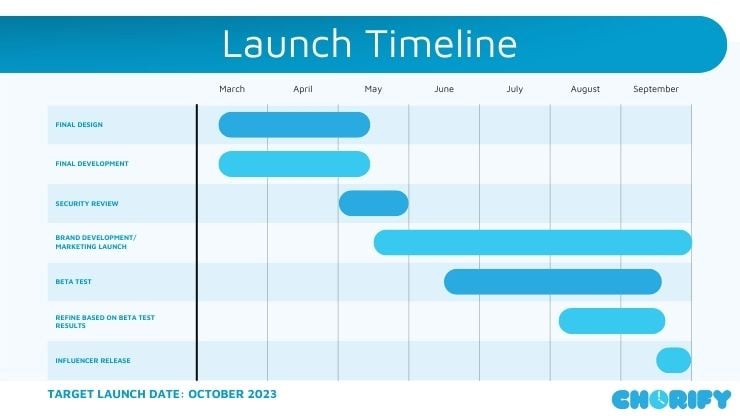
We’ve found Gantt Charts to be particularly effective for software development, as shown in our example for our fictional home task mobile app, Chorify.
As you can see, a Gantt Chart is typically organized with time on the x-axis and key tasks that need to be accomplished on the y-axis. Then the duration for each of those tasks is shown by a bar. In our example, you can see that final design and final development happen concurrently, and must be in progress before the security review can be finalized.
Another method we employ is the Checklist, which displays the objectives that have been completed to date as well as those that still need to be completed. When time-consuming tasks have already been completed, this format indicates to the investor that the project is ready for funding to move forward. We find that categorized lists work best because long and disorganized lists can be difficult to understand.
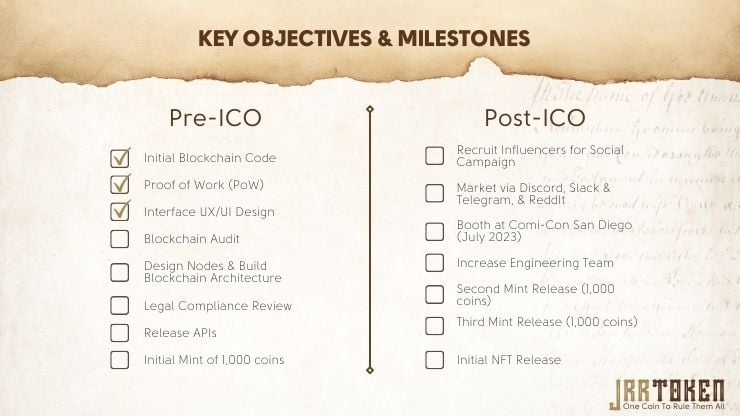
In our hypothetical cryptocurrency example, we divided the goals into two categories: pre-ICO and post-ICO (ICO stands for Initial Coin Offering, which is the official release of new cryptocurrency coin). As you can see, we're demonstrating to the investor that the blockchain code is complete, as well as the Proof of Work, which is a white paper performed by cryptocurrencies to demonstrate computational consensus. Because a Proof of Work is a critical step that all cryptocurrencies must go through, displaying it as complete will show the investor that the product has a legitimate foundation in place.
The linear timeline is likely the most common method used to show tasks over the course of time. It’s easy for a person to quickly understand that time is running in a right-to-left line.
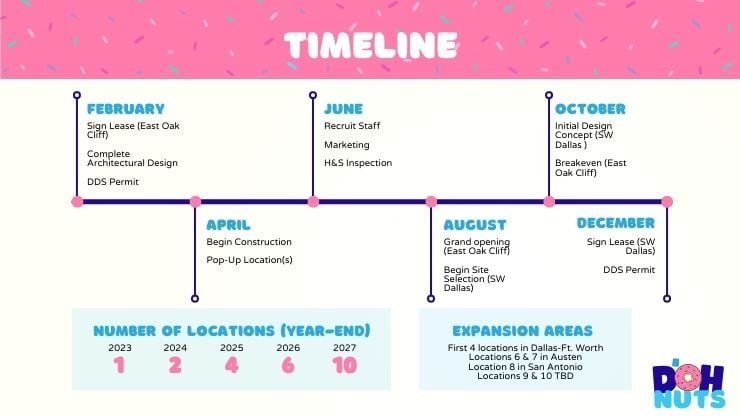
In our fictitious donut shop, D'OHNuts, we display a 10-month timeline divided into two-month intervals. Understanding the steps of the construction process is very beneficial for a retail location like this because it allows the investor to see how long it will take before revenue is generated.
If your timeline is lengthy (more than 5 years), it is beneficial to include information about what will happen in the short term. Conversely, if your timeline is shorter, adding a few long-term goals can help the investor understand you have a vision for the company after the timeline is exhausted.
Similar to the Linear Timeline, the Roadmap can also show accomplishments over time, but in a more playful and organic way. This is especially useful for established companies that want to describe the twists and turns the company has taken along the way.
In a roadmap, the key time intervals can be shown less literally, which often makes sense for operating businesses, as key milestones rarely happen at regular intervals.
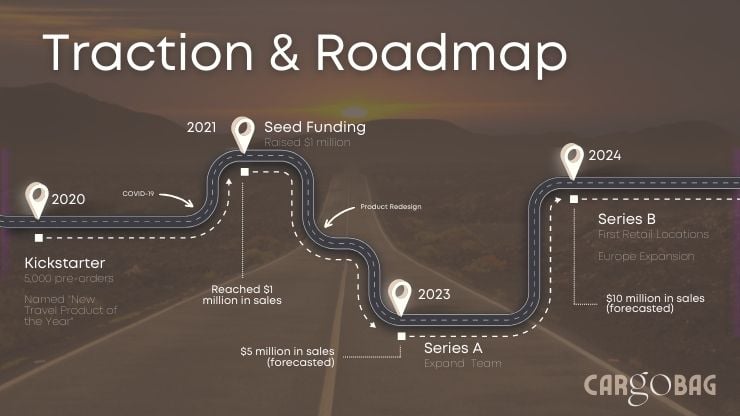
For our fictional road trip luggage company, CarGoBag, it works well to show how the company operated through a Kickstarter campaign and received Seed Funding while at the same time dealing with COVID-19 and a new product design.
Also, it doesn't have to literally be a road map (that just worked well for our example company). It could be a trail map, stair case, or even a meandering dashed line like "Family Circus."
For our final example, which works well when the timeline is less defined, is to break it down into phases.
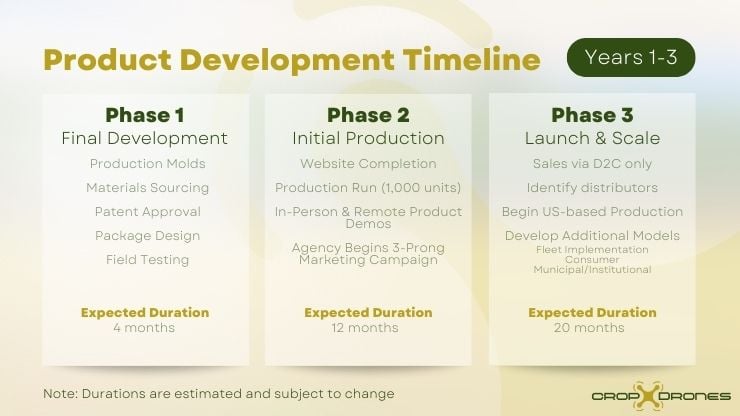
CropDrones, our fictitious agricultural drone company, is divided into three stages that will take place over the next three years. This demonstrates that, while the exact timeframe is unknown, the company is identifying the key goals that will be achieved prior to the completion of each phase.
As our examples show, there are numerous ways to inform an investor about where a startup is in its development. While each visual communication technique has its own advantages, they all clearly state that the company has taken at least some preliminary steps and has a clear long-term vision in place as it moves forward.

Entrepreneurs are often celebrated for their uncanny ability to understand others – their customers, the market, and the ever-evolving global...

Despite growth in sectors like artificial intelligence, venture capital funding has seen better days. After peaking at $347.5 billion in 2021, there...

Most people think of a professional business plan company primarily as a "business plan writer." However, here at Masterplans, we choose to approach...